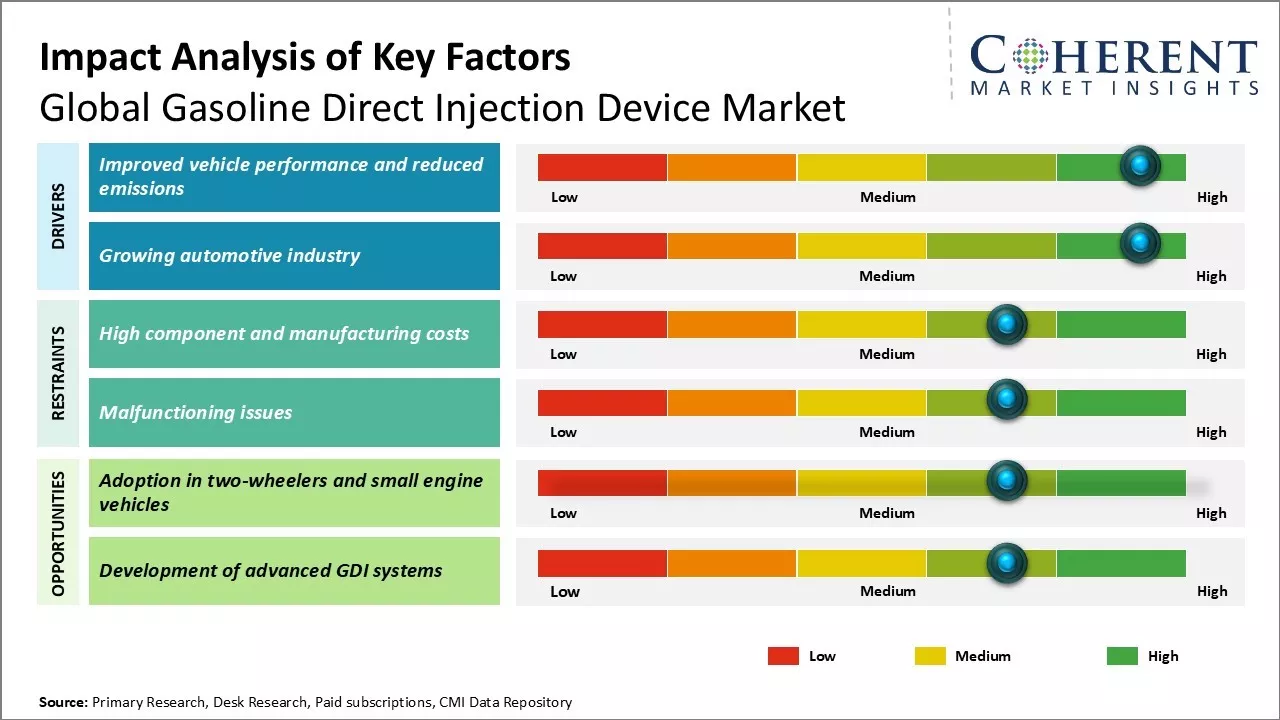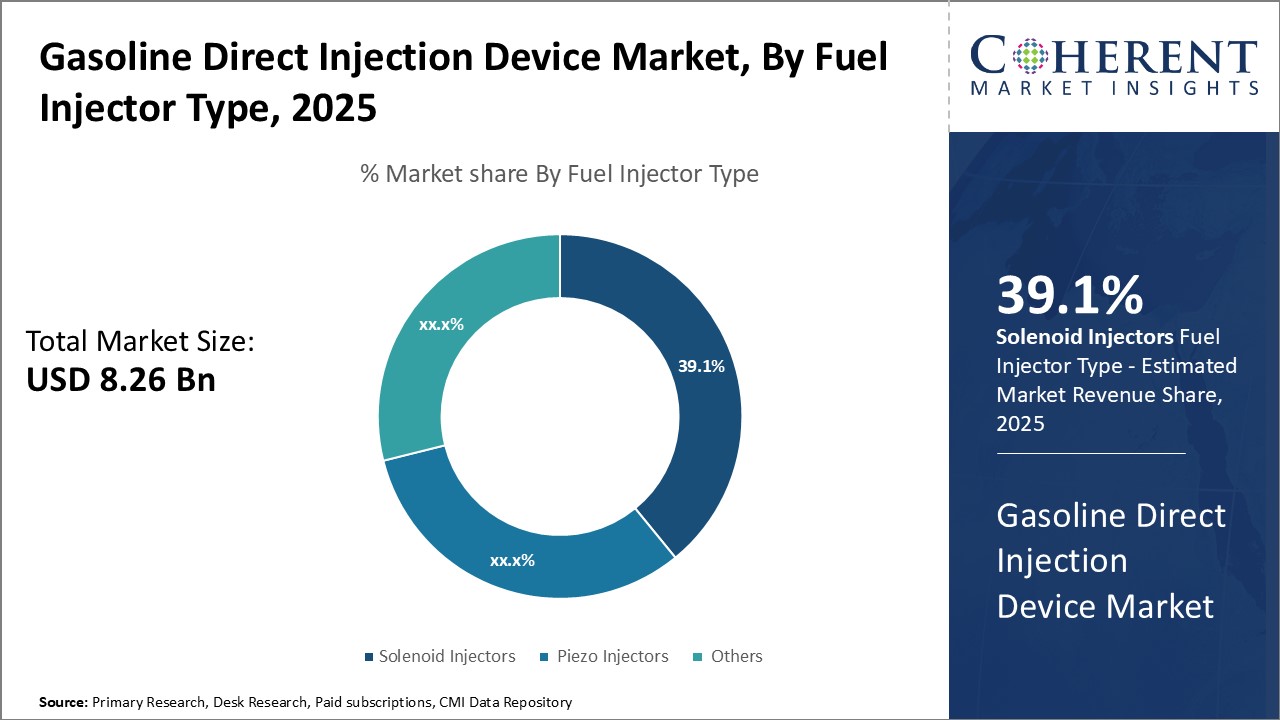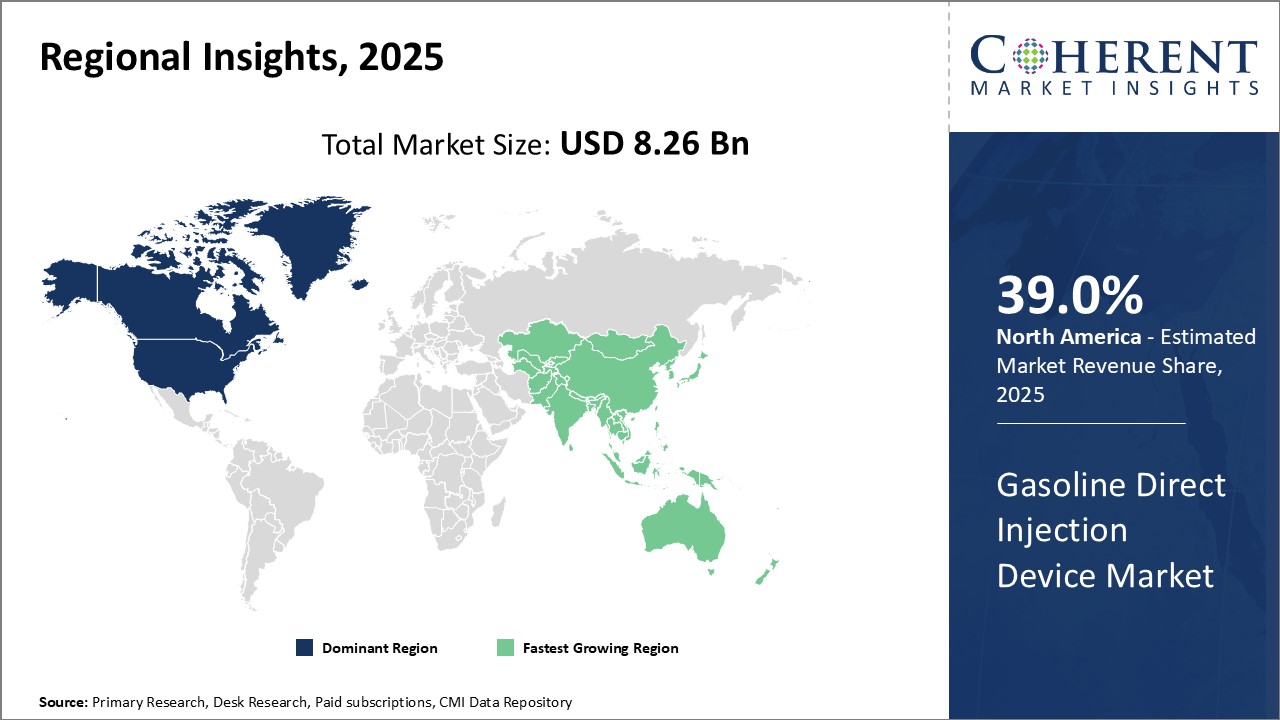The global gasoline direct injection device market is estimated to be valued at USD 8.26 Bn in 2025 and is expected to reach USD 12.68 Bn by 2032, exhibiting a compound annual growth rate (CAGR) of 6.3% from 2025 to 2032.

Discover market dynamics shaping the industry: Request sample copy
The global gasoline direct injection device market has been witnessing steady growth over the past few years owing to the rising demand for fuel-efficient vehicles around the world. Many countries have stringent emission norms that mandate automakers to integrate new emission control technologies in vehicles.
Market Driver - Improved vehicle performance and reduced emissions
One of the primary drivers of the global gasoline direct injection device market is the improved vehicle performance and reduced emissions that GDI technology enables. Gasoline direct injection systems allow for a more optimized fuel-air mixture inside the combustion chamber, resulting in a more complete combustion of fuel. This boosts engine thermal efficiency and, in turn, improves fuel economy and power output of vehicles. Direct injection of fuel also permits engines to run with a higher compression ratio without knocking. A higher compression ratio enhances an engine's thermal efficiency, thereby improving vehicle acceleration and mileage.
Moreover, by directly injecting fuel into cylinders, gasoline direct injection allows unburned fuel and emissions to be significantly reduced. Directly injecting fuel at high pressure produces a finer fuel spray which evaporates and mixes with air more uniformly than traditional port fuel injection. This optimized air-fuel ratio supported by GDI technology results in lower emissions as the fuel is able to burn more completely with less residual hydrocarbons left unburned. The finely atomized fuel spray also helps in quicker evaporation which facilitates a more controlled combustion process, resulting in fewer emissions of pollutants like carbon monoxide, nitrogen oxides and particulate matter from the vehicle tailpipe. The cleaner and more efficient combustion supported by gasoline direct injection is thus a major factor driving its increasing adoption to meet various emissions regulations.

Get actionable strategies to beat competition: Request sample copy
Growing Automotive Industry
The automotive industry around the world has been steadily growing over the past few years and this growth is fueling the rising demand for Gasoline Direct Injection (GDI) devices globally. As more vehicles are being manufactured and sold each year across major automobile markets like the U.S., China, Germany, India, and Japan, the need for advanced engine technologies is also increasing.
GDI systems are now being installed in many new models as they provide notable benefits over traditional port fuel injection systems. GDI allows for more precise fuel delivery and mixture control inside the engine cylinder, enhancing overall efficiency, power and torque output. It also helps reduce greenhouse gas emissions and improve fuel economy standards mandated by regulators. For Instance, according to the United States Environmental Protection Agency, well-designed GDI engines can achieve 15-30% better fuel efficiency compared to port injected engines.
Key Takeaways from Analyst:
The global gasoline direct injection device market is expected to witness significant growth over the forecast period. The primary driver for this growth are stringent emission norms across major countries which is increasing the demand for efficient fuel injection technologies. Gasoline direct injection allows precise fuel metering and provides better combustion which helps improve engine performance while reducing emissions. Another major opportunity in the market is the increasing adoption of turbocharged direct injection engines by automakers. This is expected to boost the demand for advanced gasoline direct injection systems and components.
North America currently dominates the global market due to stringent emission regulations. However, the Asia Pacific region is expected to expand at the fastest pace led by China and India. These regions are poised to account for a major share of the increasing global vehicle production and sales over the coming years. Safety concerns and performance issues remain key challenges for widespread adoption, particularly regarding potential carbon deposits in direct injection engines. High component costs are also restraining broader market growth.
In summary, the gasoline direct injection device market shows promising growth prospects driven by the need for meeting emission norms globally. Ongoing technological advancements to optimize fuel efficiency and reduce maintenance costs will support the market in overcoming restraints.
Market Challenge - High component and manufacturing costs
One of the key challenges for the global gasoline direct injection device market is the high component and manufacturing costs associated with GDI devices. GDI systems require sophisticated components such as gasoline injectors with much higher accuracy and precision compared to traditional port fuel injection systems. Manufacturing these critical components involve complex multi-step machining and assembly processes which make them expensive to produce at scale. The design of GDI systems also require tighter tolerances and use of more premium materials to control fuel atomization and distribution within the combustion chamber. All these factors significantly increase the bill of materials for GDI equipped vehicles compared to conventional port fuel injected vehicles. High costs pose a barrier for mass adoption of the technology especially in price sensitive developing markets. Vehicle manufacturers need to find ways to drive down the costs through value engineering and achieving higher production volumes for reasonable payback periods.
Market Opportunity - Adoption in Two-wheelers and Small Engine Vehicles
One of the major opportunities for the global gasoline direct injection device market is the rising adoption of GDI technology in two-wheelers and small engine vehicles. These vehicle segments currently dominate the global internal combustion engine vehicle population. Two-wheelers in many Asian and African countries act as the primary mode of private transportation due to their affordability and maneuverability in congested cities and towns. Similarly, demand for small commercial vans and pickup trucks is also increasing steadily across global markets. GDI systems provide an optimal solution for these small displacement engine vehicles to meet stringent emission regulations without significantly increasing costs. Leading two-wheeler and engine manufacturers are now developing GDI variants of their best-selling models and lines to tap into this untapped opportunity. It is expected to be a key driver of future revenue growth for GDI device suppliers globally.

Discover high revenue pocket segments and roadmap to it: Request sample copy
Insights by fuel injector type: Increased Precision and Flexibility Drives Growth of Solenoid Injectors
Solenoid injectors is expected to contribute 39.1% share of the global gasoline direct injection device market in 2025, owing to their superior precision and flexibility over competing technologies. Solenoid injectors utilize an electromagnet to control the opening and closing of the injector valve, allowing for precise metering of fuel supply and injection timing. This precision is crucial for optimizing engine performance attributes like fuel efficiency, power output, and emissions control.
Modern gasoline engines are designed with very tight tolerances that require precise fuel delivery to functions properly. Even tiny variations in injection timing or volume can negatively impact the combustion process. Solenoid injectors are able to meet increasingly stringent precision requirements through advances in magnetic sensor technology and injection pressure control systems. Their ability to accurately meter fuel supply on a cylinder-by-cylinder basis at high injection pressures enables optimized combustion across a wide range of engine speeds and loads.
In addition, solenoid injectors provide more flexibility than competing technologies for engine downsizing and emissions compliance. Their precision fuel metering allows for strategies like multiple injections per combustion cycle, which improve part-load efficiency in smaller displacement engines. Sophisticated injection control also supports technologies like gasoline particulate filters that are becoming more commonplace to meet ever-tightening emissions regulations. Overall, solenoid injectors' superior precision and flexibility position them as the technology of choice for satisfying the dual demands of efficiency gains and emissions reductions.
Insights by vehicle type: Growing Adoption in Passenger Vehicles Capitalizes on Convenience and Cost Benefits
The passenger cars segment is expected to contribute 35.9% share of the global gasoline direct injection device market in 2025, owing to growing adoption encouraged by convenience and cost benefits over indirect injection systems. As consumers increasingly value fuel efficiency, sophisticated gasoline direct injection (GDI) systems are emerging as an affordable option accessible to mainstream passenger vehicles.
Unlike port fuel injection, GDI eliminates the need for bulky intake manifolds and long fuel delivery lines, freeing up interior space. This allows automakers more flexibility to downsize engines without sacrificing performance or refinement characteristics valued by consumers. Compact GDI packages also reduce overall vehicle weight, further enhancing fuel economy.
Perhaps most significantly, GDI systems have seen rapid maturation and now provide performance on par with port injection while being more cost-effective to produce. Manufacturers can leverage existing engine designs and production infrastructure with a relatively minor retrofit to GDI components. Technology sharing across vehicle platforms also helps drive down individual component costs over time.
As consumer concerns over environmental impact and operating costs increase, automakers are turning to GDI as a mainstream solution capitalizing on interior space and weight savings and a gradually declining premium over port injection. Rapid diffusion into high-volume passenger cars segments indicates GDI has reached a tipping point as a flexible, cost-competitive technology for the masses.
Insights by engine capacity: Small-displacement Engines Below 2.0 Liters is Driven by Efficiency Push
The below 2.0 liters segment is expected to account for 39.2% share of the global gasoline direct injection device market in 2025, owing to the ongoing industry push for increased efficiency from downsized engines. Gasoline direct injection enables dramatic improvements in fuel economy from smaller displacement engines through strategies like turbocharging and multiple injections per cycle.
Strict regulatory targets on vehicle emissions make efficiency gains a high priority for automakers. Downsizing engine displacement through GDI is seen as a relatively low-cost approach to significantly reduce fuel consumption, especially in high-volume markets increasingly dominated by smaller passenger cars. Complex combustion techniques enabled by GDI, such as leaning out the air-fuel mixture, centralized multiple injections, and cooled EGR are optimized for small turbocharged engines.
Consumer demand for affordable high-performance vehicles is another factor driving growth below 2.0 liters. With GDI, sub-2.0-liter engines can provide the same or better acceleration and low-end torque as larger motors through techniques like multi-injection fuel staging. This improves viability of downsized engines without compromising driver experience.
As efficiency requirements tighten globally and operating costs rise, sub-2.0-liter GDI engines are increasingly seen as the sweet spot by automakers. Their optimization for advanced combustion methods cements this segment as central to strategies achieving ambitious downsizing and emissions targets.

Need a Different Region or Segment? Customize now
North America has remained the dominant regional market for gasoline direct injection devices globally. The region is expected to hold 39.0% of the market share in 2025. The U.S. is home to some of the largest automotive manufacturers like General Motors, Ford, and Fiat Chrysler who have substantially increased their production of gasoline vehicles with direct injection technology over the last decade. Coupled with higher vehicle ownership and larger individual vehicle usage compared to other regions, this has translated into significantly higher demand for direct injection systems from the automotive OEMs based in the U.S. Moreover, the presence of major gasoline direct injection device suppliers like Continental, Delphi Technologies, Denso, Magneti Marelli, and Walbro catering to these domestic automakers has made North America a key manufacturing base. The strong industrial ecosystem between automakers and suppliers has enabled customized product development and rapid technology adoption.
Asia Pacific region has emerged as the fastest growing market for gasoline direct injection devices globally. Countries like China, India, and Indonesia have seen surge in personal vehicle ownership over the last few years on the back of rising disposable incomes and a growing middle-class population. As these emerging markets transition from carbureted to fuel-injected engines, the demand for direct injection devices has increased substantially. Local automakers in the region including SAIC, Great Wall, Geely, BYD, and Tata Motors have also increased their gasoline vehicle portfolio using direct injection systems. Further, parts suppliers from Japan, South Korea, and Taiwan have established local manufacturing bases to capitalize on the opportunities in these high growth markets. With strong production growth rates projected across multiple high volume automotive markets, Asia Pacific is expected to surpass North America as the largest gasoline direct injection device market by the end of the decade.
Gasoline Direct Injection Device Market Report Coverage
| Report Coverage | Details | ||
|---|---|---|---|
| Base Year: | 2024 | Market Size in 2025: | USD 8.26 Bn |
| Historical Data for: | 2020 To 2024 | Forecast Period: | 2025 To 2032 |
| Forecast Period 2025 to 2032 CAGR: | 6.3% | 2032 Value Projection: | USD 12.68 Bn |
| Geographies covered: |
|
||
| Segments covered: |
|
||
| Companies covered: |
Robert Bosch GmbH, Denso Corporation, Delphi Automotive LLP, Continental AG, Magneti Marelli, TI Fluid Systems, Stanadyne LLC, Keihin Corporation, Eaton Corporation, Infineon Technologies, STMicroelectronics, GP Performance, Marelli Europe S.p.A., Woodward Inc., PurePower Technologies, Renesas Electronics, MSR–Jebsen Technologies, Currawong Engineering, Aisin Seiki Co., Ltd., and Hitachi Automotive Systems |
||
| Growth Drivers: |
|
||
| Restraints & Challenges: |
|
||
Uncover macros and micros vetted on 75+ parameters: Get instant access to report
*Definition: The global gasoline direct injection device market consists of automotive fuel delivery components that directly inject gasoline into the combustion chamber of a spark-ignition engine. This includes critical components like fuel injectors, fuel pumps, and pressure regulators. Gasoline direct injection systems are gaining popularity as they provide benefits like improved fuel efficiency, torque, and reduced emissions over traditional port fuel injection systems. The market comprises companies that develop and manufacture direct fuel injection technologies and components for gasoline engines across passenger cars.
Share
Share
About Author
Gautam Mahajan is a Research Consultant with 5+ years of experience in market research and consulting. He excels in analyzing market engineering, market trends, competitive landscapes, and technological developments. He specializes in both primary and secondary research, as well as strategic consulting across diverse sectors.
Missing comfort of reading report in your local language? Find your preferred language :
Transform your Strategy with Exclusive Trending Reports :
Frequently Asked Questions
Joining thousands of companies around the world committed to making the Excellent Business Solutions.
View All Our Clients
US Reciprocal Tax Impact Analysis On Gasoline Direct Injection Device Market
Stay updated on tariff changes with expert insights and timely information